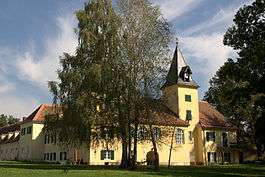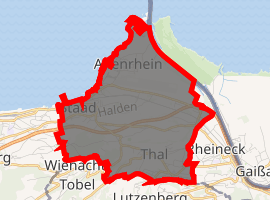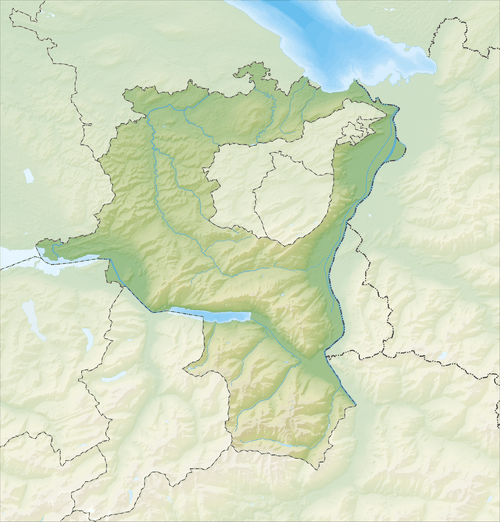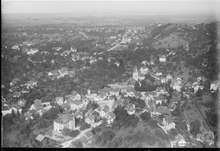Thal, St. Gallen
Thal is a village and municipality in the Wahlkreis (constituency) of Rorschach in the canton of St. Gallen in Switzerland. Besides the village of Thal itself, the municipality also includes the villages of Altenrhein, Buechen, Buriet and Staad.
Thal | |
|---|---|
 | |
 Coat of arms | |
Location of Thal 
| |
 Thal  Thal | |
| Coordinates: 47°28′N 9°34′E | |
| Country | Switzerland |
| Canton | St. Gallen |
| District | Wahlkreis Rorschach |
| Government | |
| • Mayor | Robert Raths |
| Area | |
| • Total | 9.58 km2 (3.70 sq mi) |
| Elevation | 415 m (1,362 ft) |
| Population (2018-12-31)[2] | |
| • Total | 6,570 |
| • Density | 690/km2 (1,800/sq mi) |
| Postal code | 9425 |
| SFOS number | 3237 |
| Surrounded by | Fußach (AT-8), Gaißau (AT-8), Heiden (AR), Höchst (AT-8), Horn (TG), Lutzenberg (AR), Nonnenhorn (DE-BY), Rheineck, Rorschacherberg, Wasserburg (Bodensee) (DE-BY), Wolfhalden (AR) |
| Website | www SFSO statistics |
History
Thal is first mentioned in 1163 as curtis tale.[3]
The 1983 UCI Road World Championships (cycling) took place in Altenrhein, a village in the municipality.
Geography
Thal has an area, as of 2006, of 9.6 km2 (3.7 sq mi). Of this area, 44% is used for agricultural purposes, while 13.1% is forested. Of the rest of the land, 35.8% is settled (buildings or roads) and the remainder (7.2%) is non-productive (rivers or lakes).[4]
The municipality was part of the Unterrheintal District, but in 2004 became part of the Rorschach Wahlkreis. It is located between the Appenzell foothills, the Buchberg and Lake Constance. It consists of the haufendorf village (an irregular, unplanned and quite closely packed village, built around a central square) of Thal and (since 1803) the villages of Altenrhein, Buechen, Buriet, Staad and a number of scattered hamlets.
In the North and East, the municipality borders the old bed of the Rhine river (Alter Rhein) and Austria.

Coat of arms
The blazon of the municipal coat of arms is Argent a Grape Azure slipped embowed and leaved Vert.[5]
Demographics
Thal has a population (as of 31 December 2018) of 6,571.[6] As of 2007, about 18.9% of the population was made up of foreign nationals. Of the foreign population, (as of 2000), 112 are from Germany, 188 are from Italy, 417 are from ex-Yugoslavia, 93 are from Austria, 42 are from Turkey, and 181 are from another country.[7] Over the last 10 years the population has grown at a rate of 5.5%. Most of the population (as of 2000) speaks German (91.3%), with Albanian being second most common ( 2.0%) and Italian being third ( 1.8%).[4] Of the Swiss national languages (as of 2000), 5,475 speak German, 23 people speak French, 110 people speak Italian, and 9 people speak Romansh.[8]
The age distribution, as of 2000, in Thal is; 803 children or 13.4% of the population are between 0 and 9 years old and 798 teenagers or 13.3% are between 10 and 19. Of the adult population, 682 people or 11.4% of the population are between 20 and 29 years old. 986 people or 16.4% are between 30 and 39, 906 people or 15.1% are between 40 and 49, and 734 people or 12.2% are between 50 and 59. The senior population distribution is 524 people or 8.7% of the population are between 60 and 69 years old, 315 people or 5.3% are between 70 and 79, there are 210 people or 3.5% who are between 80 and 89, and there are 37 people or 0.6% who are between 90 and 99, and 1 person who is 100 or more.[8]
In 2000 there were 707 persons (or 11.8% of the population) who were living alone in a private dwelling. There were 1,350 (or 22.5%) persons who were part of a couple (married or otherwise committed) without children, and 3,345 (or 55.8%) who were part of a couple with children. There were 319 (or 5.3%) people who lived in single parent home, while there are 30 persons who were adult children living with one or both parents, 12 persons who lived in a household made up of relatives, 29 who lived household made up of unrelated persons, and 204 who are either institutionalized or live in another type of collective housing.[8]
In the 2007 federal election the most popular party was the SVP which received 41.4% of the vote. The next three most popular parties were the CVP (16.1%), the SP (14.2%) and the FDP (12.1%).[4]
In Thal about 72.9% of the population (between age 25-64) have completed either non-mandatory upper secondary education or additional higher education (either university or a Fachhochschule).[4] Out of the total population in Thal, as of 2000, the highest education level completed by 1,150 people (19.2% of the population) was Primary, while 2,324 (38.8%) have completed their secondary education, 663 (11.1%) have attended a Tertiary school, and 220 (3.7%) are not in school. The remainder did not answer this question.[8]
The historical population is given in the following table:[3]
| year | population |
|---|---|
| 1850 | 2,748 |
| 1900 | 3,546 |
| 1910 | 3,888 |
| 1930 | 3,625 |
| 1950 | 4,025 |
| 1970 | 4,919 |
| 1990 | 5,399 |
Transportation
Staad railway station and Altenrhein airport are located in the municipality.
Economy
As of 2007, Thal had an unemployment rate of 2.27%. As of 2005, there were 95 people employed in the primary economic sector and about 31 businesses involved in this sector. 1,717 people are employed in the secondary sector and there are 101 businesses in this sector. 1,327 people are employed in the tertiary sector, with 226 businesses in this sector.[4]
As of October 2009 the average unemployment rate was 4.9%.[9] There were 371 businesses in the municipality of which 98 were involved in the secondary sector of the economy while 246 were involved in the third.[10]
As of 2000 there were 1,139 residents who worked in the municipality, while 2,004 residents worked outside Thal and 2,074 people commuted into the municipality for work.[11]
Religion
From the 2000 census, 2,539 or 42.3% are Roman Catholic, while 2,221 or 37.0% belonged to the Swiss Reformed Church. Of the rest of the population, there is 1 individual who belongs to the Christian Catholic faith, there are 106 individuals (or about 1.77% of the population) who belong to the Orthodox Church, and there are 190 individuals (or about 3.17% of the population) who belong to another Christian church. There are 4 individuals (or about 0.07% of the population) who are Jewish, and 296 (or about 4.94% of the population) who are Islamic. There are 21 individuals (or about 0.35% of the population) who belong to another church (not listed on the census), 455 (or about 7.59% of the population) belong to no church, are agnostic or atheist, and 163 individuals (or about 2.72% of the population) did not answer the question.[8]
Sights
The Schlosslandschaft Rorschach / Alter Rhein, a number of castles in a region along the Rhine river, is designated as part of the Inventory of Swiss Heritage Sites. The Schlosslandschaft is shared between Berg, Goldach, Mörschwil, Rheineck, Rorschacherberg, St. Margrethen, Steinach, Thal and Tübach.[12]
References
- "Arealstatistik Standard - Gemeinden nach 4 Hauptbereichen". Federal Statistical Office. Retrieved 13 January 2019.
- "Ständige Wohnbevölkerung nach Staatsangehörigkeitskategorie Geschlecht und Gemeinde; Provisorische Jahresergebnisse; 2018". Federal Statistical Office. 9 April 2019. Retrieved 11 April 2019.
- Thal in German, French and Italian in the online Historical Dictionary of Switzerland.
- Swiss Federal Statistical Office accessed 5 January 2010
- Flags of the World.com Archived 5 June 2011 at the Wayback Machine accessed 5 January 2010
- Swiss Federal Statistical Office - STAT-TAB, online database – Ständige und nichtständige Wohnbevölkerung nach institutionellen Gliederungen, Geburtsort und Staatsangehörigkeit (in German) accessed 23 September 2019
- Der Kanton St. Gallen und seine Menschen in Zahlen - Ausgabe 2009 (in German) accessed 30 December 2009
- Canton St. Gallen Statistics-Hauptergebnisse der Volkszählung 2000: Regionen- und Gemeindevergleich-Personen Archived 3 October 2009 at the Wayback Machine (in German) accessed 30 December 2009
- St Gallen Canton statistics-Unemployment (in German) accessed 30 December 2009
- St Gallen Canton statistics-Businesses Archived 7 July 2011 at the Wayback Machine (in German) accessed 31 December 2009
- St Gallen Canton statistics-Commuters Archived 22 July 2009 at the Wayback Machine (in German) accessed 31 December 2009
- ISOS site accessed 8 December 2009